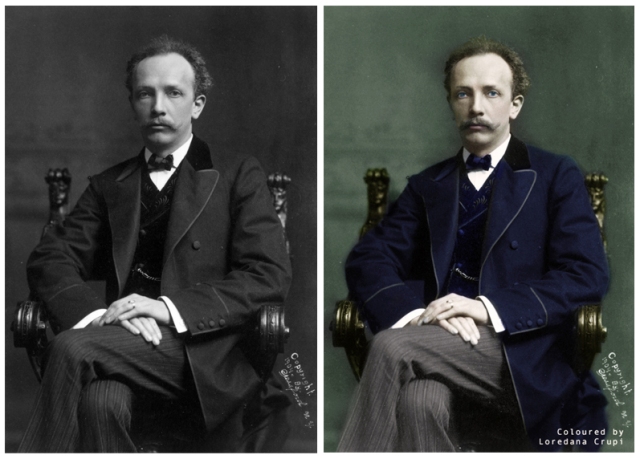Day 124 of Colourisation Project – September 8
Challenge: to publish daily a colourised photo that has some significance around the day of publication.
65 years ago this day, September 8, 1949, German composer, Richard Georg Strauss passed away. Considered a leading, avant-garde composer of the late Romantic and early modern eras, his work had a profound influence on the development of 20th-century music. Best known for his operas, Der Rosenkavalier and Salome; his lieder, especially Four Last Songs, and orchestral works, such as Metamorphosen, life in Germany during the Third Reich presented monumental career and life challenges for Strauss.
In the latter half of a brilliant career, Strauss was never be able to shrug the Nazi sympathiser label. And for decades after his death, despite having been cleared of Nazi collaboration, his music suffered the same fate as Wagner’s. His association with the Third Reich tarnished his reputation and consequently his music, which at various times was banned or reviled as a result. Whilst in Israel, Wagner is still verboten, the embargo on Strauss was at last lifted in the 1990s.
Ever one to split public opinion, Richard Strauss has been described as a selfish and morally bankrupt man in one corner and a well-connected, pragmatic musician, hopeful of using his influence for good, in the other corner.
Throughout his life, Strauss lobbied to improve the economic situation of musicians in Germany. He worked hard to have copyright laws revised, and for increased government funding for professional musicians. His political acumen however was perhaps clouded by the propaganda machine of the Third Reich. Strauss accepted an appointment as the first president of the Reichsmusikkammer (RMK) in 1933 from the minister of propaganda, Joseph Goebbels, who was responsible for all aspects of cultural activity.
Asked later why he accepted, Strauss said, “I hoped that I would be able to do some good and prevent worse misfortunes.”
Though Strauss privately loathed Goebbels and referred to him as ‘a pipsqueak’, he dedicated an orchestral song, Das Bächlein (The Little Brook) to Goebbels, in order to gain his support in extending German music copyright laws from 30 years to 50 years.
Over the Christmas period of 1934, Strauss composed Olympische Hymne for the 1936 Berlin Games, a commission from the German Olympic Committee. Matters soon grew tense, however as Strauss refused to sever ties with his Jewish librettist, Stefan Zweig, with whom he wrote the opera, Die Schweigsame Frau (The Silent Woman) in 1934, despite the latter’s protestations to break up the partnership. In June 1935, the Gestapo intercepted a letter from Strauss to Zweig in which Strauss characterized his position as RMK president as merely play-acting. This resulted in Strauss’ forced resignation and the cancellation of all further productions of the opera.
Though Strauss wrote a personal letter to Hitler assuring him that the letter to Zweig ‘does not represent my view of the world nor my true conviction,’ Hitler never replied.
Just months after his dismissal, his Olympic Hymn premiered at the Summer Olympic Games in Berlin. Strauss was thereafter denounced by the Nazi party.
Condemned for criticising the Nazi regime, and accused of being pro-Nazi, Strauss was apolitical at heart. He placed music above the politics of the day and was determined to preserve and to conduct the music of banned composers such as Mahler and Debussy. In 1933, Strauss wrote in his private notebook:
“I consider the Streicher-Goebbels Jew-baiting as a disgrace to German honour, as evidence of incompetence—the basest weapon of untalented, lazy mediocrity against a higher intelligence and greater talent.”
Forced to make concessions and submit to their will, Strauss’s suffering was not only professional but also personal. His own family did not escape the onslaught of antisemitism. His daughter-in-law Alice was Jewish, as were his grandchildren. Subjected to the constant barbs of antisemitism, Strauss’s grandsons were stoned on their way to school and called ‘dirty Jews’. Strauss’s son, Franz and his wife were repeatedly questioned by the Gestapo.
Strauss was able to call on his connections and to use every shred of his influence as ‘Germany’s greatest living composer’ to protect his family from the full force of persecution during Kristallnacht in November 1938. In 1942 he moved with them to Vienna, where they benefited from some protection but 32 members members of Alice’s immediate family were not so lucky. They all perished in Theresienstadt concentration camp.
~~~~~~~~~~~~~~~~~~~~~~~~
Strauss’s name continues to raise the question of art over morality. Where do we draw the line? Should we? The conductor Arturo Toscanini once famously declared, “To Richard Strauss, the composer, I take off my hat. To Richard Strauss, the man, I put it on again.”
Although he was condemned by many after the war including 1929 Nobel laureate and German novelist, Thomas Mann as a ‘Hitlerian composer,’ Allied denazification tribunals eventually cleared Strauss’s name, and he returned to his home in Garmisch in 1949, where he died three months after his 85th birthday celebrations.
Georg Solti, who had arranged Strauss’s 85th birthday celebration, also directed an orchestra during Strauss’s burial. Michael Kennedy in his biography, Richard Strauss: Man, Musician, Enigma, shares Solti’s description of the singing by the famous trio from Rosenkavalier, ‘each singer broke down in tears and dropped out of the ensemble, but they recovered themselves and we all ended together.’
______________________________________________________________
“I want to be able to depict in music a glass of beer so accurately that every listener can tell whether it is a Pilsner or a Kulmbacher.” – Richard Strauss

